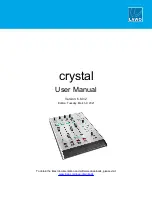
4
Determine how many of the three middle pole segments you
need to use, based on the thickness of the ice.
TIP:
The top of the transducer must be below the bottom of
the ice for best performance.
5
Screw together the needed segments, with the shortest
segment on the bottom of the pole.
6
Use the included hex wrench to attach the transducer to
the bracket with the shoulder screw , flat washer , and
rubber washer .
NOTE:
You must fully tighten the shoulder screw to secure
the transducer to the bracket. The recommended torque
applied to the shoulder screw is 2.5 lb-ft. (3.4 N-m).
7
Using the hex wrench and the M6 screws , attach the two
halves of the bracket around the pole.
8
Use the hook and loop straps to secure the transducer cable
to the pole.
9
Position the transducer for the desired view.
TIP:
Turn the mount one click to change the orientation from
forward to down .
10
Place the mount base around the hole in the ice.
11
Rotate the handle to aim the transducer.
Effective Forward and Down Range
NOTE:
Water conditions and bottom conditions affect the depth
and range performance of the transducer. You should use
caution and observe the water depth and range, especially when
your unit is operating in manual range or depth mode.
When operating in LiveVü Forward mode, the transducer has an
effective forward range of between five and eight times the
depth of the water. For example, in 3 m (10 ft.) of water, the
effective forward range is between 15 and 24 m (between 50
and 80 ft.). Water conditions and bottom conditions affect the
actual range.
When operating in LiveVü Down mode, the fore/aft range is
equal to the depth of the water. For example, in 10 m (33 ft.)
water depth, the screen will display 5 m (16 ft.) fore and 5 m
(16 ft.) aft of the transducer. Deeper water provides a greater
fore and aft range.
Connecting and Stowing the Cables
CAUTION
Ensure that you connect the correct spade connector to the
correct battery terminal. Damage to the battery or device, or
bodily harm may occur if the device is improperly connected to
the battery.
NOTE:
The gray
+
and
-
connectors on the power cable are for
connecting to a PS22 transducer.
1
Connect the 4-pin power cable and network cable to the
chartplotter.
2
If you are connecting a PS22 transducer, connect the power
leads to the gray bare wire connectors on the power cable.
3
Slide the positive (red) spade connector onto the positive
(red) terminal on the battery.
4
Slide the negative (black) spade connector onto the negative
(black) terminal on the battery.
2






















